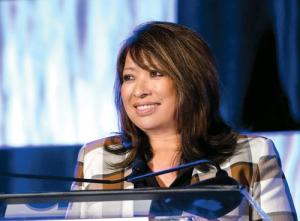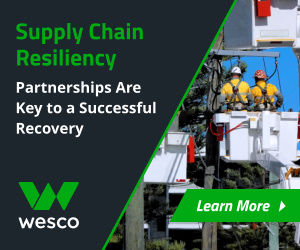San Diego Gas & Electric
Caroline Winn is the CEO of San Diego Gas & Electric.
How do today's natural gas utilities find the right balance, rigorously addressing ESG priorities while continuing to meet the needs of the communities they serve via gas utility service? In the conversations below, leaders from CenterPoint Energy, Eversource, NiSource, NW Natural, and Sempra Energy (both at San Diego Gas & Electric and at the parent) take on directly how they are managing that balance.

PUF's Steve Mitnick: What technologies are you excited about that San Diego Gas & Electric is piloting or deploying, to help accelerate progress toward carbon neutrality, and at the same time create a more resilient and smarter grid?
Caroline Winn: Storage has the potential to be a game changer. That's particularly so in California, where we must regularly curtail solar production in the middle of the day, because supply far exceeds demand.
We've been investing in a variety of different storage technologies for a decade now. In recent years, our storage portfolio has grown big, because we see the need to further maximize the use of renewable energy.
We see the need to strengthen grid reliability and resiliency. As climate conditions continue to worsen, energy storage is more important. Over the next year, we will have tripled our energy storage capacity in our region.
Earlier this summer, we brought online a thirty-megawatt lithium-ion battery and two more large lithium-ion batteries in development.
However, our portfolio goes beyond lithium ion. It includes emerging technologies such as vanadium redux flow battery that we installed in 2017, and we have an iron flow battery we're using as part of a microgrid.
We're also working on a hydrogen-based long duration energy storage pilot project. This project is important because at this point, energy storage technology is in its infancy, in that most batteries on the market last four hours.
The holy grail is long-duration energy storage that can provide backup during extended power outages, and can help balance supply and demand, not just across hours, but across days, months, and seasons.
That leads me to the second item I'm excited about — hydrogen. We're developing a green hydrogen project, and it's part of that long-duration energy storage pilot. We'll install hydrogen storage containers that will help support over ten hours of energy storage for a fuel cell.
This project is in process of being co-located with one of our microgrids in a remote desert town. It will leverage solar energy available in the community to produce green hydrogen. Hydrogen innovations can help solve California's solar curtailment problems.
Last year, California curtailed nearly 1.6 million megawatt hours of renewable energy. There have been times when California had to pay neighboring states to take its excess solar.
The third technology that I'm excited about, because it's another resiliency tool, is microgrids. We got an early start with microgrid technology in 2012, when we worked with the Department of Energy on installing our first microgrid.
We always had the goal of running it on one hundred percent renewable energy and we're currently developing four more microgrids.
We're doing that to keep critical facilities and vulnerable communities online in high-risk fire areas during extreme events when we have to turn off power to prevent fires.
Microgrids will also integrate advanced energy storage systems and have onsite renewable generation. That's an exciting development we're continuing to build on.
The last one is, we're proud about building our own private LTE network. It's designed to meet our operational needs. It's a 5G-ready network and will help support the rollout of our falling conductor protection system.
That protection system is smart enough to understand when there's a disturbance in the system, and if the power line breaks, it stops the power before it hits the ground and potentially causes an ignition.
The falling conductor protection system requires speeds of fifty to a hundred milliseconds to operate effectively. This LTE project is an important enabler of that falling conductor technology.
PUF: While you're pursuing decarbonization, you're also trying to ensure reliability of the grid. How are you dealing with that and also the wildfire risk?
Caroline Winn: We're constantly balancing multiple competing priorities. Our customers, policymakers, and regulators, expect us to deliver clean energy, but also safe, reliable, and resilient energy.
California's made progress in greening the grid with renewables, as solar energy powers much of our grid. We also have wind power. But there are challenges in the evening hours after solar generation starts dropping off. California ISO grid operators face challenges in keeping up with demand during what we call that net peak period, which typically comes after the total demand peak and when the solar drops off.
California grid operators have had to cope with the worsening effects of climate change. We've had record heat waves that have strained the grid. There have been supply constraints due to wildfire-related transmission outages.
When all these factors converge, it is a perfect storm. You have grid emergencies and rotating outages. With this intermittency of renewable resources and growing severity of climate impacts on the grid, it's important we have a diversified portfolio of energy resources and resiliency tools to provide an extra layer of protection.
We need adequate resources when the sun isn't shining, and energy storage is one of them. We're all heading toward having green electrons, green electricity, but you also need green molecules to help provide that load-following resource when the sun isn't shining.
That's where hydrogen becomes important. That's why we're doing some of these pilot projects.
PUF: What are green bonds and how does that factor in?
Caroline Winn: In August, Sempra, our parent company, published a sustainable financing framework, and it outlined the criteria and parameters for any issuance by any of the Sempra companies. This sustainable financing framework is a best practice for companies wanting to issue sustainable financing.
Under this framework, SDG&E issued seven hundred and fifty million in green bonds to fund projects in certain categories, like climate change adaptation, which is around all the wildfire mitigation we're doing, all the work to build a more resilient grid. It also will fund some clean energy solutions like energy storage, hydrogen, electrification, and clean transportation.
We have a significant amount of spend in those areas, and the green bonds will cover those expenses. It's a relatively new and developing source of financing. It may not necessarily represent cheaper financing, but it expands our financing sources, which is key to our capital plan.
The green bond priorities are aligned with our priorities in how we're spending at SDG&E in terms of resiliency, wildfire mitigation, and clean solutions. We believe green bonds are an important part of our future.
If we're serious about fighting climate change, we have to tackle transportation, which is the largest source of greenhouse gas emissions. In California, it represents over forty percent of the greenhouse gas emissions. In San Diego, it's over fifty percent.
Green bonds will help us to fund projects that will reduce tailpipe emissions and electrify vehicles and equipment. Over the past decade at SDG&E, we've developed a robust portfolio of EV charging infrastructure programs to support electrification.
We leaned in early on electrifying transportation and filed an application in the 2014 timeframe. We started installing electric vehicle charging stations at two niche areas that normally wouldn't get EV chargers, like multifamily units. There are lots of people who live in townhomes and apartments that want to get an EV but can't charge their vehicles.
The second place is businesses. People say they can get to work, they can't necessarily get home. We have over three thousand chargers that we own, operate, and maintain in those two areas. We're installing them at state parks, beaches, and schools.
Part of our EV infrastructure program, also an important part of climate change adaptation, is we established equity goals.
That was to install a certain percentage of chargers in and around communities of concern that historically have been overburdened by environmental pollution. We've applied to create a rebate program for customers buying used EVs in order to put EVs within reach of more people.
We are constantly looking for partnerships in our regions, and over the past year we've created a regional collaborative called Accelerate to Zero Emissions. It's a coalition of local governments and agencies, nonprofits, and academics, to align resources and investments around this unified strategy.
We've made a commitment to transition our entire company fleet to a hundred percent zero emission by 2035. The technologies don't exist today. You have to be working with manufacturers, especially of some of these heavy-duty transportation vehicles, big trucks.
There is a lot of creative work going on in clean transportation. We have a pilot we're working with a school district in San Diego County, and it's our Vehicle to Grid Pilot.
There are six electric buses, and they're providing energy back to the grid at times the buses aren't in use. The buses are used during the day in the morning and the afternoon. It's proof of concept.
PUF: Talk about the philosophy and what you do to reach out and bring in a lot of players?
Caroline Winn: We learned a lot. We've had some devastating wildfires in San Diego, in 2007. We asked, what is it we can do to be better? We don't want our infrastructure to be a cause of a wildfire.
We've realized we can't do this alone and require help. We have to do this with partnerships from our fire agencies, academia, and private industry, to solve some of these really wicked hard problems, as I call them.
Climate change in general requires all hands-on deck. Whether it's the public, private, non-profit, or academic sectors, it's important to work together to accelerate progress in greenhouse gas reductions.
Some of these are not our friends. But we have to get them in the room, because at the end of the day, we're aligned. Our sustainability strategy engages a broad range of stakeholders from local governments to environmental, non-profits, and business civic groups.
We have three terrific universities locally, and we've forged partnerships. We even have the Scripps Institution of Oceanography, which is a world-leading institute that I'm proud to be on the board.
There are so many resources, and we need to take advantage of that. It's about bringing them all together, especially when we don't agree on things other than maybe our goal of working together on a climate action plan.
We're partnering with all the local governments on that. The federal government is an important partner. Last month we hosted White House National Climate Advisor, Gina McCarthy, for a visit to our emergency operation center where we briefed her on our wildfire safety and climate adaptations initiative.
That was one of the highlights of my career. We're closely following the debate around President Biden's infrastructure plan that calls for significant investments in clean transportation, grid modernization, and other areas to fight climate.
What you’re seeing is everyone wants the same thing, and the way that we’re going to come together as quickly and affordable as possible is these partnerships. This is going to take bold vision, ideas, and massive investments, and not just from the energy industry. It’s important we move the needle together.
ESG Naturally conversations:



